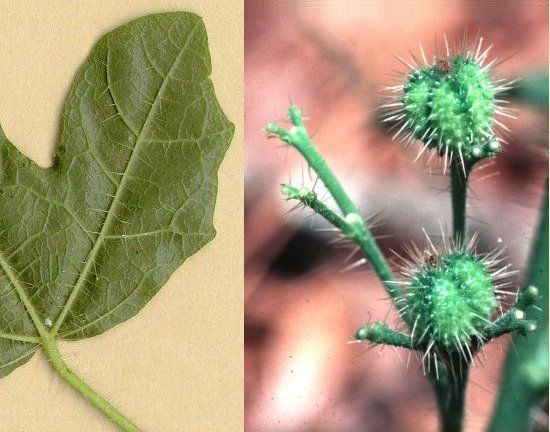Classification
Scientific Name: Cnidoscolus stimulosus (Michx.) Engelm. & A. Gray
Common Name(s): bull-nettle, tread-softly, finger-rot, spurge-nettle
Family: Euphorbiaceae (spurge family)
Description
Perennial herb with elongated tuberous root and milky sap; stems, leaves, flowers, and fruit with needle-like, stinging hairs.
Stems erect to reclining, branched or unbranched, to 1 m (3.25 ft) tall but usually much shorter.
Leaves alternate, bright green to dark green, variably, and deeply 3– to 5–palmately divided (like a hand), 8–20 cm (3–8 in) long and wide; leaf margins coarsely toothed to entire;petioles (leaf stalks) long, often almost as long as the leaf blades.
Flowers unisexual, male and female flowers together in forked clusters terminating the stem; 1.5 cm (0.5 in) wide, with 5 white, petal-like calyx lobes and a narrow tubular base 1.5 cm (0.5 in) long.
Capsule oval in outline, 3-parted, 1-1.5 cm (0.54-0.6 in) long, explosively dehiscing to release 3 seeds; seeds oval in outline, 8 mm (0.3 in) long, brown with darker brown mottling, with conspicuous caruncle (protuberance) at one end.

Credit: Kent D. Perkins
Field Recognition Features. Herbaceous plants covered with stiff stinging hairs; palmately 3– to 5–lobed leaves, conspicuous tubular-based white flowers in a cluster terminating the stem; 3-parted bristly capsule with 3 mottled seeds. Blooming all year in Florida.
Distribution. Florida: native; nearly throughout the state. General: along the Coastal Plain from southeast Virginia to South Florida and westward to Louisiana.
Habitat. Dry, often sandy, areas such as sandhills, open woods, beaches, scrub, and disturbed areas (such as roadsides, fields, and lawns).
Similar Species
None, although species of Urtica (true stinging nettles) also have stinging hairs (see Comments below).
Toxicity
Irritant compounds that cause intense stinging and itching fill the long, stiff, hollow hairs on the stem, leaves, flowers, and fruits (Figure 2). Although not intensively studied, the injection mechanism may be similar to that in Urtica species: each hair ends in a blunt tip that breaks off, permitting injection of the poison into the skin. Often a rash (or tiny red bumps) appear after the burning sensation wears off (usually less than 30 minutes). In sensitive individuals, the rash or dull purplish discoloration may persist for several days.

Credit: Left: Kent D. Perkins; Right: Walter S. Judd
Economic Uses
The starchy, tuberous roots are edible when cooked and taste like white potato. However, excavating the roots requires care since touching the above-ground plant parts (covered with stinging hairs) must be avoided. The milky sap has been used in herbal medicine.
Comments
The unrelated true nettles (species of Urtica) also have stinging hairs but are characterized by trailing, weak stems, opposite triangular leaves, and minute greenish flowers and fruit in congested clusters. A plant fact sheet for these species is also available.
Selected References
Morton, J. F. 1974. Folk Remedies of the Low Country. E. A. Seaman Publishing, Inc., Miami, Florida.
_____. 1974. Wild Plants for Survival in south Florida. Trend House, Tampa, Florida.
_____. 1982. Plants Poisonous to People in Florida and other warm Areas. Published by the author, Stuart, Florida.
Perkins, K. D. & W. W. Payne. 1981 [reprint]. Guide to the poisonous and irritant plants of Florida. Circular 441. Gainesville: University of Florida Institute of Food and Agricultural Sciences.
Webster, G. L. 1967. The genera of the Euphorbiaceae in the southeastern United States. J. Arnold Arbor. 48: 303–430.
Wunderlin, R. P. and B. F. Hansen. 2003. Guide to Vascular Plants of Florida. 2nd ed. University Press of Florida, Gainesville.